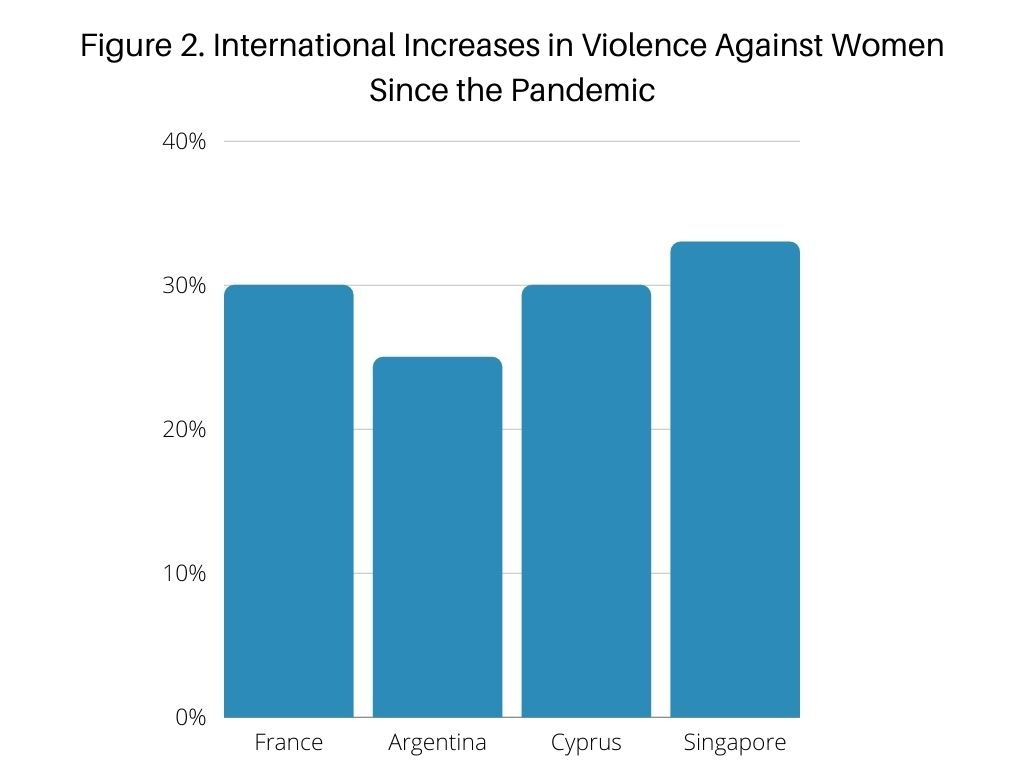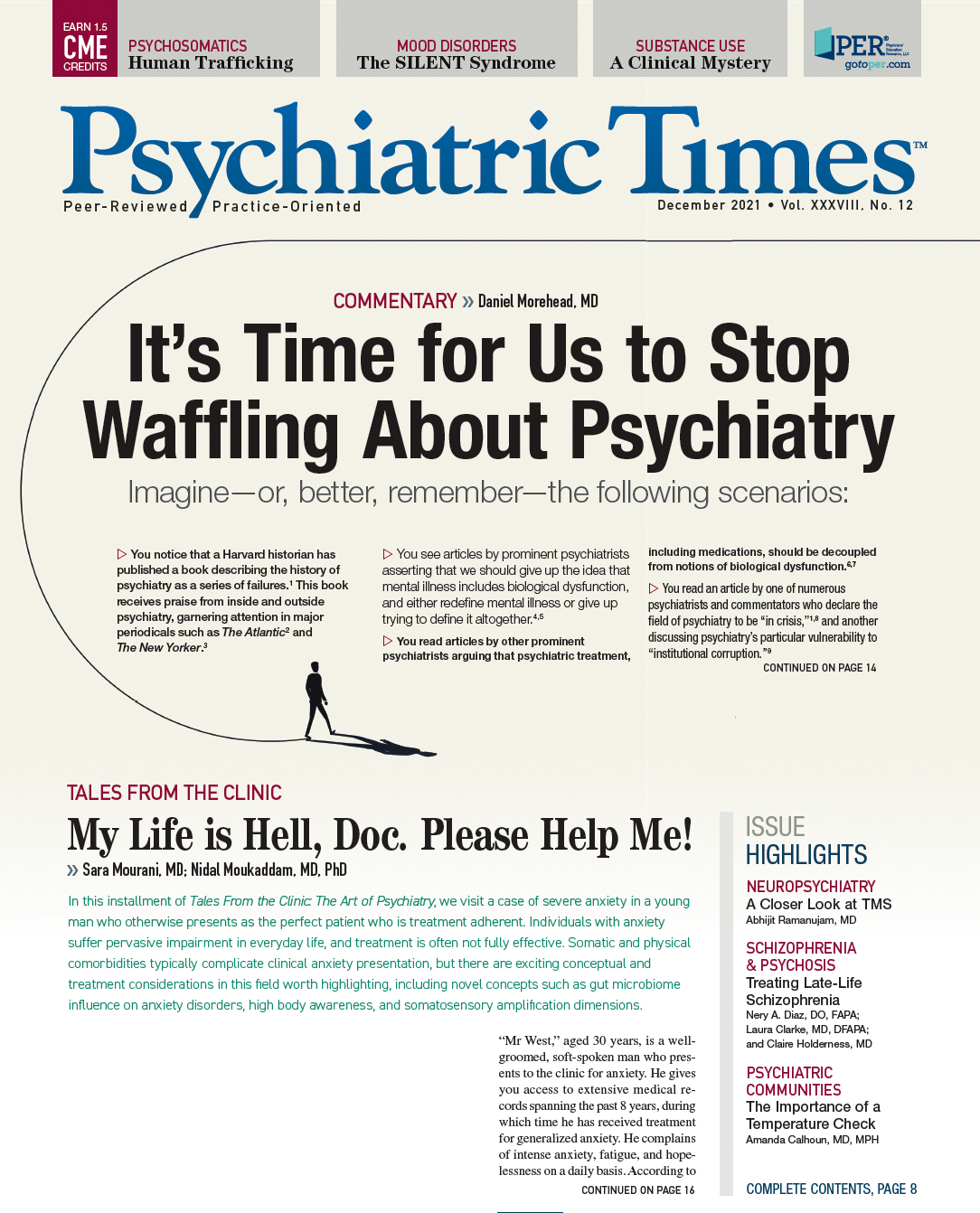SPECIAL REPORT: GLOBAL PSYCHIATRY
Sex-specific differences in various biological functions as well as in brain neuroanatomy and circuits may result in different prevalence, symptomatology, treatment responses, and outcomes in neuropsychiatric and many other disorders.1-4 In addition, men and women are not equally exposed to psychosocial stressors such as violence, among many others.5 How many sex/gender differences in health are due to biology or to the consequences of behavioral and sociological factors remains to be sorted out. This article will detail how women’s mental health is in need of improvement, and how the COVID-19 pandemic has highlighted a number of preexisting difficulties.
Also In This Special Report
Inspiring Collaboration in Cardiovascular Health
The recent mobilization of cardiologists is a perfect example of how we could advance women’s health, especially mental health. In women, cardiovascular disease is the leading cause of death, causing 35% of all deaths worldwide. Yet it remains underdiagnosed and undertreated, and women remain underrepresented in clinical trials. Apart from common risk factors that are shared by males and females, sex-specific factors such as premature menopause, gestational diabetes, hypertension during pregnancy, preterm delivery, polycystic ovary syndrome, systemic inflammatory and autoimmune disorders may play a specific role in women. Other important and underrecognized risk factors (abuse and intimate partner violence, socioeconomic deprivation), most frequently observed in women, may also play an additional role.4
Risk factors that were observed more traditionally in men have increased in women. For example, historically, women have used tobacco, alcohol, or illicit drugs less often than men, and they have consumed alcohol in lower amounts than men. However, over time, the gradual change in the societal role of women and the lessening of social taboos have led to a rise in both the frequency and level of alcohol, tobacco, and illicit drug consumption among women.6
Women usually start using psychoactive substances, including alcohol, as coping strategies to face depression, anxiety, and negative feelings, whereas men usually are more influenced by peers or sensation seeking. Consequently, the greater exposure of women to negative life events such as trauma and violence is a major contributing factor to the narrowing gap between rates of psychoactive drug use among men and women. Sex hormones and differences in pharmacokinetics and neurobiological circuits may also contribute to differences in susceptibility to dependence.
Moreover, men and women are differentially affected by triggers for relapse to drug taking. Potenza et al7 have studied neural correlates of cue-induced craving states in women and men addicted to cocaine and reported sex differences in cue-induced craving, with corticostriatal-limbic hyperactivity being linked to stress cues in women but to drug cues in men. In addition, women suffer more severe consequences of alcohol, tobacco, and drug use with lower doses than men; they also suffer from pregnancy complications (for review see Fonseca et al, 2021; Thibaut et al, 2019).8,9 Finally, women have a higher risk of relapse but achieve better results than men when they adhere to specialized treatment. Gender-oriented treatment is needed to take into account gender-related vulnerabilities.
In partnership with the Icahn School of Medicine at Mount Sinai, the journal The Lancet has convened a cardiovascular disease commission, including experts from 11 countries.4 The commission proposed 10 recommendations to reduce this global burden by 2030, including educating health care providers and patients on early detection; using heart health programs in highly populated and underdeveloped regions; and prioritizing sex-specific research in women on heart disease and intervention strategies.4 We should be inspired by this interesting collaboration in women’s health and create a similar list of recommendations, focusing on prevention, early detection, and treatment, to reduce the global burden of mental illness in women.
Lessons Learned From the Pandemic
The COVID-19 pandemic highlighted the urgent need for sex-specific clinical and pharmacological studies. The fatality rate with COVID-19 and the severity of the disease were higher in men than in women; for every 10 females, there were 15 confirmed cases in males who have died and 18 male intensive care unit admissions.10 The higher death ratio reported in men may be partly explained by more preexisting cardiovascular or metabolic diseases, as well as higher risk-associated behaviors such as alcohol abuse, tobacco smoking, and less compliance with sanitation measures.11 Hormonal (eg, estrogens) and genetic differences in the immune response may protect women against infectious diseases, but, at the same time, put them at higher risk of autoimmune disorders and inflammatory diseases.12-15 Yet the COVID-19 pandemic has affected women more than men, both as frontline workers and at home due to lockdown and quarantine measures.
Worldwide, 70% of the frontline health workforce (nurses, midwives, and community health workers) and facility service staff (cleaners, laundry, catering) is made up of women.16 As a consequence, women were more likely to be exposed to the virus.17 For example, in Italy and Spain, 66% and 72% of infected health workers were females, compared with only 34% and 28% of males, respectively (Figure 1).16 Moreover, the severity of COVID-19 was higher in pregnant women, with a higher risk of intensive care unit admission and potential risks for the fetus and/or the baby.18-20
In addition, psychological consequences of the COVID-19 pandemic were more often observed in women, both in the general population and in COVID-19 positive patients, compared with prepandemic data.21 The mean rate of depressive disorders for females is approximately twice that of males (1.63-3.89), and anxiety disorders are more common in women than in men, increasing two- to threefold in the occurrence of generalized anxiety disorder and personality disorders.22,23 These preexisting sex differences were even greater after the pandemic, as females were more affected by the pandemic than males for major depressive disorders (B=0.1 [0.1-0.2; P<.001]) and for anxiety disorders (B=0.1 [0.1-0.2; P<.001]), especially in the younger age group.
In the same way, in Japan, Tanaka and Okamoto24 reported that, following a decrease by 14% during the first 5 months of the pandemic (February to June 2020), suicide rates increased by 16% (between July and October 2020), with a larger increase among females and younger populations, compared to males and older populations.
In post-illness stage, posttraumatic stress disorder (PTSD) was reported in one-third of 381 patients who initially sought treatment at the emergency department in Rome (Italy) for severe SARS-CoV-2. Sex (being a female), delirium or agitation, and persistent medical symptoms were associated with PTSD.25
Overall, women were more likely to be affected by the economic and social consequences of the COVID-19 pandemic.16 Additional household tasks, lower salaries, and less secure employments were more likely to occur in women compared to men. Riley et al26 have conducted a cross-sectional study in 2020 among 152 women experiencing homelessness and unstable housing in San Francisco. Half of these women experienced moderate-to-severe depressive and anxiety symptoms during the pandemic; these symptoms were associated with increased challenges accessing non–COVID-19 care and managing symptoms for chronic medical conditions.
Women were also at higher risk of domestic violence during the pandemic, with increases found internationally, which may, in turn, induce or aggravate psychiatric symptoms (Figure 2).16,27
Understudied Sex/Gender Effects
Finally, despite different pharmacokinetic and pharmacodynamic properties of many compounds according to sex, medications have been studied essentially in men, and the data obtained about the clinical efficacy and potential adverse effects have been extrapolated to women. In addition, women of childbearing age were often excluded from clinical trials. Furthermore, in several cases, adverse events of medications during pregnancy became apparent only after many reports of toxicity to the fetus and/or the newborn (eg, sodium valproate, lithium).
Yet despite known sex-specific differences, sex/gender effects remain largely under-studied in clinical and pharmaceutical trials. For example, 10 prescription drugs were withdrawn from the US market between 1997 and 2000. Eight of these 10 compounds showed higher health risks for women than for men. In 4 cases, they were prescribed more often to women, while the other 4 had more adverse events in women even though they were widely prescribed to both.28 Moreover, of the 350 cases of anaphylaxis after vaccination in adults, reported to the Vaccine Adverse Event Reporting System in the US between 1990 and 2016, 80% were observed in females, with influenza vaccines being most frequently reported.29
In the United States, of the 300 new drug applications received by the FDA (1995-2000), only 163 included sex-based pharmacodynamic analysis, and 11 drugs showed a 40% or greater sex difference in pharmacokinetics. This information was listed on the drug label, yet no differences in dosing between males and females were recommended.1 The European Association of Science Editors reported that sex was not reported for 22% to 60% of animals used in biological and immunological preclinical studies. In a study based on 768 trials, 89% reported recruitment of males and females, but less than 1% reported that they analyzed gender effects.30
Howard et al2 analyzed 728 papers published in JAMA Psychiatry and The British Journal of Psychiatry. Among them, 16% stratified analyses by sex, but no studies reported a calculation powered for the analysis of its primary outcome by sex. In fact, a gender-sensitive perspective is urgently needed.
In 2016, the Cochrane Sex/Gender Methods Group published a paper entitled, “Why sex and gender matter in health research synthesis.”31 Clinical and pharmacological research reflects a mostly male perspective, assimilating women to men despite known biological and pharmacological differences. Participation of women of reproductive age in clinical trials is necessary, provided that there is adequate risk protection in case of pregnancy. In the near future, every pharmaceutical compound should clearly mention whether trials were conducted in women or not, and whether different adverse effects might be expected in women. For this purpose, the US National Institutes of Health, the Canadian Institutes of Health Research, and the European Commission have called for sex/gender analyses in all clinical trials. Heidari et al32 have published a procedure for reporting sex and gender information in study design, analysis, and interpretation of the data.
Concluding Thoughts
According to a recent statement from Phumzile Mlambo-Ngcuka, former executive director of United Nations (UN) Women, “This is a moment for governments to recognize both the enormity of the contribution women make and the precarity of so many.”16
Women are currently facing a number of important issues: financial crisis is gradually developing in this post–COVID-19 period and, as a consequence, mental health issues are likely to grow exponentially. According to the UN, women aged 24 to 34 years are already 25% more likely than men to face extreme poverty.16 As such, the UN recommends allocating additional resources to protect women, putting women at the center of policy changes, and collecting more sex-disaggregated data to analyze the impact of pandemics on women.16 Moreover, the 17 Sustainable Development Goals proposed by the UN offer a unique opportunity to achieve gender equality before 2030,33 which is a key element in sustaining women’s health.
Dr Thibaut is professor of psychiatry at the University of Paris and University Hospital Cochin-Tarnier, and president of the International Association of Women's Mental Health.
References
1. Anderson GD. Sex and racial differences in pharmacological response: where is the evidence? Pharmacogenetics, pharmacokinetics, and pharmacodynamics. J Women’s Health (Larchmt). 2005;14(1):19-29.
2. Howard LM, Ehrlich AM, Garnlen F, Oram S. Gender-neutral mental health research is sex and gender biased. Lancet Psychiatry. 2017;4(1):9-11.
3. McCarthy MM. Sex differences in the developing brain as a source of inherent risk. Dialogues Clin Neurosci. 2016;18(4):361-372.
4. Vogel B, Acevedo M, Appelman Y, et al. The Lancet women and cardiovascular disease Commission: reducing the global burden by 2030. Lancet. 2021;397(10292):2385-2438.
5. García-Moreno C, Riecher-Rössler A, eds. Violence against Women and Mental Health. Karger; 2013:1-11.
6. Thibaut F. Overview of women and addiction. In: Chandra PS, Herrman H, Fisher J, Riecher-Rössler A, eds. Mental Health and Illness Worldwide, Mental Health and Illness of Women. Springer; 2020:423-442.
7. Potenza MN, Hong KI, Lacadie CM, et al. Neural correlates of stress-induced and cue-induced drug craving: influences of sex and cocaine dependence. Am J Psychiatry. 2012;169(4):406-414.
8. Fonseca F, Robles-Martínez M, Tirado-Muñoz J, et al. A gender perspective of addictive disorders. (Gender, F Thibaut and J Labad Arias, Section Editors). Current Addiction Reports. 2021;8:89-99.
9. Thibaut F, Chagraoui A, Buckley L, et al. WFSBP * and IAWMH ** Guidelines for the treatment of alcohol use disorders in pregnant women. World J Biol Psychiatry. 2019;20(1):17-50.
10. The Sex, Gender and COVID-19 Project. The COVID-19 sex-disaggragated data tracker. Updated October 27, 2021. Accessed November 3, 2021. https://globalhealth5050.org/the-sex-gender-and-covid-19-project/the-data-tracker/
11. Johnson HD, Sholcosky D, Gabello K, et al. Sex differences in public restroom handwashing behavior associated with visual behavior prompts. Percept Mot Skills. 2003;97(3 Pt 1):805-810.
12. Klein SL, Flanagan KL. Sex differences in immune responses. Nat Rev Immunol. 2016;16(10):626-638.
13. Zhang Q, Bastard P, Liu Z, et al. Inborn errors of type I IFN immunity in patients with life-threatening COVID-19. Science. 2020;370(6515):eabd4570.
14. Bastard P, Rosen LB, Zhang Q, et al. Autoantibodies against type I IFNs in patients with life-threatening COVID-19. Science. 2020;370(6515):eabd4585.
15. Tsiambas E, Chrysovergis A, Papanikolaou V, et al. Chromosome X riddle in SARS-CoV-2 (COVID-19) - related lung pathology. Pathol Oncol Res. 2020;26(4):2839-2841.
16. United Nations. Policy brief: the impact of COVID-19 on women. April 9, 2020. Accessed November 3, 2021. https://www.unwomen.org/-/media/headquarters/attachments/sections/library/publications/2020/policy-brief-the-impact-of-covid-19-on-women-en.pdf?la=en&vs=1406
17. Boniol M, McIsaac M, Xu L, et al. Gender equity in the health workforce: analysis of 104 countries. World Health Organization. March 2019. Accessed November 3, 2021. https://apps.who.int/iris/bitstream/handle/10665/311314/WHO-HIS-HWF-Gender-WP1-2019.1-eng.pdf
18. Capobianco G, Saderi L, Aliberti S, et al. COVID-19 in pregnant women: a systematic review and meta-analysis. Eur J Obstetr Gynecol Reprod Biol. 2020;252:543-558.
19. Della Gatta AN, Rizzo R, Pilu G, Simonazzi G. Coronavirus disease 2019 during pregnancy: a systematic review of reported cases. Am J Obstet Gynecol. 2020;223(1):36-41.
20. Vivanti AJ, Vauloup-Fellous C, Prevot S, et al. Transplacental transmission of SARS-CoV-2 infection. Nat Commun. 2020;11(1):3572.
21. COVID-19 Mental Disorders Collaborators. Global prevalence and burden of depressive and anxiety disorders in 204 countries and territories in 2020 due to the COVID-19 pandemic. Lancet. 2021;398(10312):1700-1712.
22. Yu S. Uncovering the hidden impacts of inequality on mental health: a global study. Transl Psychiatry. 2018;8(1):98.
23. Jalnapurkar I, Allen M, Pigott AT. Sex differences in anxiety disorders: a review. J Psychiatry Depress Anxiety. 2018;4:11.
24. Tanaka T, Okamoto S. Increase in suicide following an initial decline during the COVID-19 pandemic in Japan. Nat Hum Behav. 2021;5(2):229-238.
25. Janiri D, Carfi A, Kotzalidis GD, et al. Posttraumatic stress disorder in patients after severe COVID-19 infection. JAMA Psychiatry. 2021;78(5):567-569.
26. Riley ED, Dilworth SE, Satre DD, et al. Factors associated with symptoms of depression and anxiety among women experiencing homelessness and unstable housing during the COVID-19 pandemic. JAMA Netw Open. 2021;4(7):e2117035.
27. UN Women. COVID-19 and ending violence against women and girls. April 6, 2020. Accessed November 3, 2021. https://www.unwomen.org/-/media/headquarters/attachments/sections/library/publications/2020/issue-brief-covid-19-and-ending-violence-against-women-and-girls-en.pdf?la=en&vs=5006
28. United States Government Accountability Office. Drug safety: most drugs withdrawn in recent years had greater health risks for women. January 19, 2001. Accessed November 3, 2021. https://www.gao.gov/assets/gao-01-286r.pdf
29. Su JR, Moro PL, Ng CS, et al. Anaphylaxis after vaccination reported to the Vaccine Adverse Event Reporting System, 1990-2016. J Allergy Clin Immunol. 2019;143(4):1465-1473.
30. Schiebinger L, Leopold SS, Miller VM. Editorial policies for sex and gender analysis. Lancet. 2016;388(10062):2841-2842.
31. Sex/Gender Methods Group. Why sex and gender matter in health research synthesis. Cochrane Methods Equity. 2016. Accessed November 3, 2021. https://methods.cochrane.org/equity/sex-and-gender-analysis
32. Heidari S, Babor TF, De Castro P, et al. Sex and gender equity in research: rationale for the SAGER guidelines and recommended use. Res Integr Peer Rev. 2016;1:2.
33. UN Women. Turning promises into action: gender equality in the 2030 Agenda for Sustainable Development. February 14, 2018. Accessed November 3, 2021. http://www.unwomen.org/-/media/headquarters/attachments/sections/library/publications/2018/sdg-report-summary-gender-equality-in-the-2030-agenda-for-sustainable-development-2018-en.pdf?la=en&vs=949)










